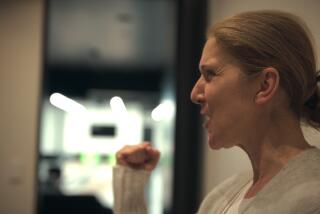Puncturing the Surface of Pride
- Share via
Dear readers: This week we begin a new monthly column written by Claire Panosian Dunavan, a Los Angeles physician. The column will tell the real-life stories of patients, doctors and other health professionals, providing a behind-the-scenes look at the practice of medicine.*
*
I’ll never forget the day my mentor cried. It was 1974, and I was a third-year medical student--a rookie ready to doctor. I was also terrified to doctor, but that was a secret I didn’t share with anyone.
My mentor, a New Englander who grunted more than talked, was a veteran fourth-year student. His name was O’Leary. I looked up to him because, unlike me, he’d seen things, knew things and his hands didn’t shake when he drew blood.
I’m telling O’Leary’s story because it shows a side of medicine doctors usually hide--from patients and themselves.
The story begins with medical procedures. Sound boring? Well, they’re not boring to medical students. Some can’t wait to poke and cut. Others, like me, dreaded the thought. We were the nonsurgeons.
O’Leary was a surgeon-in-the-making and a maestro of procedures. And not just easy ones like drawing blood. Hard ones like needling the chest for fluid and lumbar punctures, also called spinal taps.
That summer, spinal taps scared me more than anything. Some nights, the mere idea kept me awake. But from books, I knew the drill. First, roll the patient sideways into a ball. Then clean and numb the lower back. Then pop a needle between two vertebrae and voila! In the best of worlds, fluid would flow.
According to O’Leary, the whole thing took 60 seconds. Sure, I thought, if you don’t jam the needle in bone.
Please don’t misunderstand. Despite my fears, someday I hoped to be a doctor who would tap spines bravely and well. Someday.
*
Before I could perform a spinal tap I needed to watch one. “See one, do one, teach one” was our motto back then. Sure enough, the day dawned. I would see, and O’Leary, supervised by a resident doctor, would do.
As I recall, there was no time to waste. Our patient was an old man with lung cancer who had been deteriorating for weeks. Suddenly, he went hot and stiff. We feared meningitis, a deadly infection diagnosed only by spinal tap.
But first we needed to check for swelling in his brain. And so we huddled, darkened the room and peered into his eyes.
I couldn’t see a thing, but O’Leary was dead-sure. With a grunt, he gave the go-ahead to proceed.
O’Leary then set up the spinal tray, his brow beetled, his concentration fierce. Yes, he had great hands. When they punctured, they were steady as steel.
But just as the first drops of spinal fluid began to flow, our resident suddenly shouted: “Code blue!” The patient had stopped breathing.
My God! In the midst of a flawless procedure, disaster.
Within an instant, the cardiac arrest team descended like hail. Valiantly, they pumped the chest, squeezed the breathing bag, injected drugs. But, in the end, death won.
But where was O’Leary? He was nowhere to be found. I finally discovered him in a back room, his head bowed, his face swollen with tears. Silently, I tiptoed out.
Days later, an autopsy revealed the truth. The surface of our patient’s brain was studded with tumors that had spread from his lungs--a finding that spelled doom. But it was the spinal tap that killed him, the pathologist added, due to a sudden change in brain pressure. It had nothing to do with technique. Just rotten luck, for patient and doctor.
That’s O’Leary’s story. Why do I remember it years later? I guess, in a way, I’m still sifting through its lessons.
One lesson has to do with times and technology. Today we often do sophisticated scans before spinal taps. In 1974, that scan would have spared our patient’s life, at least briefly. But it wasn’t available.
Another lesson, how we doctors sometimes put pride before humanity. Why did O’Leary leave when the going got tough? I don’t know, but perhaps he couldn’t cry in front of colleagues. Doctors don’t do that.
As for me, seeing O’Leary cry was a revelation. A tough young doctor in the making, a terminal patient, a perfect procedure--some would have blown the whole thing off, downed coffee and let it go. Instead O’Leary cried, as people do.
No longer a rookie, 25 years later I still thank O’Leary for crying and showing me it was OK. The older I get, the more I do cry--for sadness, failures and triumphs too. Medicine has them all.
*
Claire Panosian Dunavan is a Los Angeles internist and infectious diseases specialist. She can be reached by e-mail at cpanosian@mednet.ucla.edu.
* The Doctor Files runs monthly in Health.






